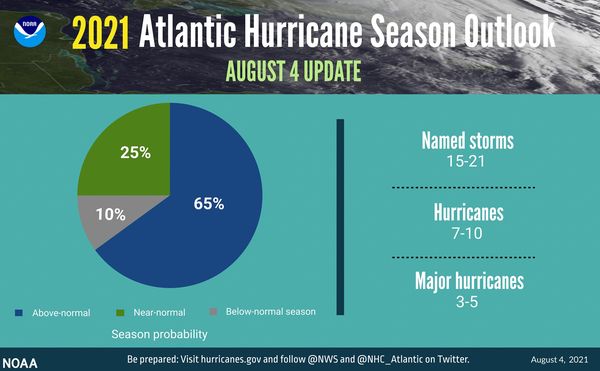
The 2021 Atlantic hurricane season is well underway, and atmospheric and oceanic conditions remain conducive for an above-average hurricane season, according to the annual mid-season update issued by NOAA’s Climate Prediction Center, a division of the National Weather Service.
The latest outlook reflects that the number of expected named storms (winds of 39 mph or greater) is 15-21, including 7-10 hurricanes (winds of 74 mph or greater), of which 3-5 could become major hurricanes (Category 3, 4, or 5 with winds 111 mph or greater). This updated outlook includes the 5 named storms that have formed so far, with Hurricane Elsa becoming the earliest 5th named storm on record.
“After a record-setting start, the Atlantic 2021 hurricane season does not show any signs of relenting as it enters the peak months ahead,” said Rick Spinrad, Ph.D., NOAA administrator. “NOAA will continue to provide the science and services that are foundational to keeping communities prepared for any threatening storm.”

NOAA GOES-East satellite image of Hurricane Elsa as it moves up Florida’s west coast on July 6, 2021. (NOAA)
NOAA scientists predict that the likelihood of an above-normal 2021 Atlantic hurricane season is 65%. There is a 25% chance of a near-normal season and a 10% chance of a below-normal season.
“A mix of competing oceanic and atmospheric conditions generally favor above-average activity for the remainder of the Atlantic hurricane season, including the potential return of La Nina in the months ahead,” said Matthew Rosencrans, lead seasonal hurricane forecaster at NOAA’s Climate Prediction Center.
Atlantic sea surface temperatures are not expected to be as warm as they were during the record-breaking 2020 season; however, reduced vertical wind shear and an enhanced west Africa monsoon all contribute to the current conditions that can increase seasonal hurricane activity. These conditions are set against the backdrop of the ongoing warm phase of the Atlantic Multi-Decadal Oscillation, which has been favoring more active hurricane seasons since 1995.
“Now is the time for families and communities to ensure their preparations are in place,” said National Weather Service Director Louis W. Uccellini, Ph.D. “These storms can be devastating, so be prepared for all possible outcomes by staying tuned to the forecast and following safety information and possible evacuation notifications issued by emergency officials.”
NOAA’s update to the 2021 outlook covers the entire six-month hurricane season, which ends Nov. 30. Throughout the hurricane season, NOAA’s National Hurricane Center (NHC) provides the hurricane track and intensity forecasts that emergency managers and communities rely on across areas at risk during a landfalling storm. NHC is the source for all watches and warnings for tropical storms, hurricanes, and related storm surge. The seasonal outlook from NOAA is not a landfall forecast as landfalls are typically only predictable within about a week of a storm potentially reaching a coastline.
Learn more about NOAA’s comprehensive expertise across all aspects of hurricane science and forecasting with our Hurricane Resource Guide on NOAA.gov. Visit FEMA’s Ready.gov for the latest information about hurricane preparedness and evacuation safety.
Source NOAA


Bulloch Public Safety
7/18/2025 Booking Report for Bulloch County

Bulloch Public Safety
7/17/2025 Booking Report for Bulloch County

Bulloch Public Safety
06/23/2025 Booking Report for Bulloch County

Bulloch Public Safety
06/30/2025 Booking Report for Bulloch County

Bulloch Public Safety
7/14/2025 Booking Report for Bulloch County

Bulloch Public Safety
7/11/2025 Booking Report for Bulloch County

Bulloch Public Safety
7/09/2025 Booking Report for Bulloch County








